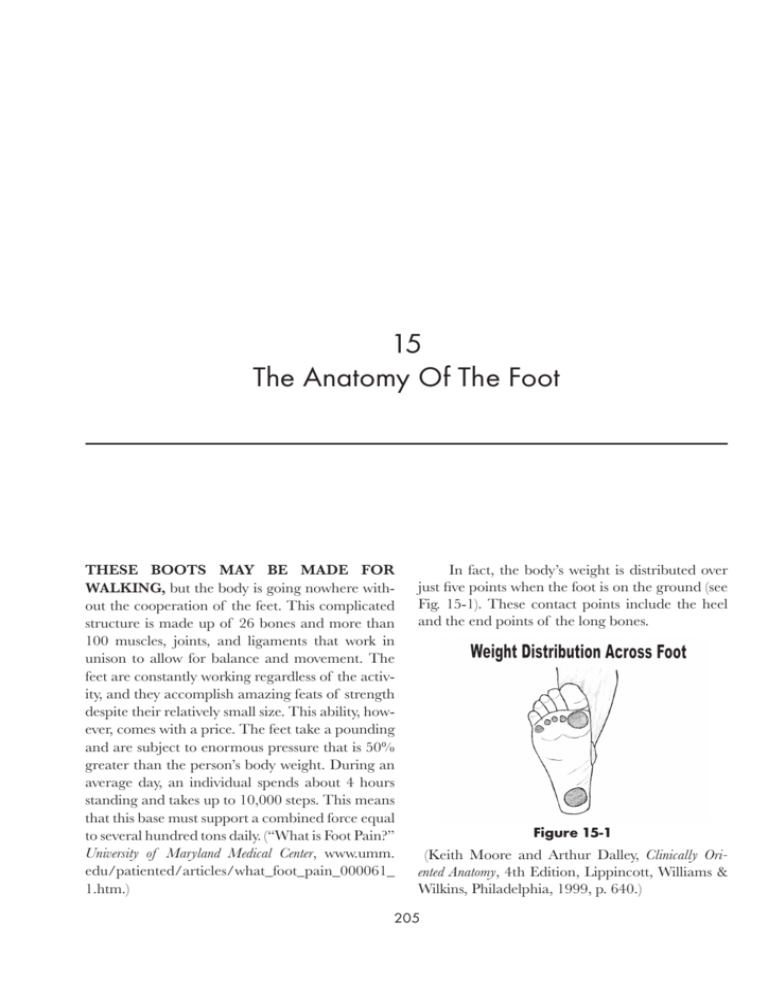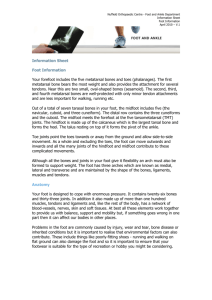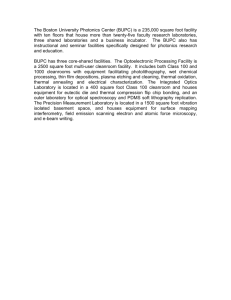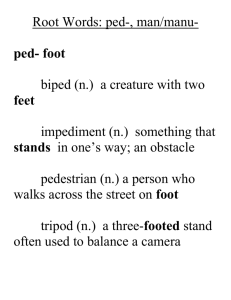15 The Anatomy Of The Foot
advertisement

15 The Anatomy Of The Foot THESE BOOTS MAY BE MADE FOR WALKING, but the body is going nowhere without the cooperation of the feet. This complicated structure is made up of 26 bones and more than 100 muscles, joints, and ligaments that work in unison to allow for balance and movement. The feet are constantly working regardless of the activity, and they accomplish amazing feats of strength despite their relatively small size. This ability, however, comes with a price. The feet take a pounding and are subject to enormous pressure that is 50% greater than the person’s body weight. During an average day, an individual spends about 4 hours standing and takes up to 10,000 steps. This means that this base must support a combined force equal to several hundred tons daily. (“What is Foot Pain?” University of Maryland Medical Center, www.umm. edu/patiented/articles/what_foot_pain_000061_ 1.htm.) In fact, the body’s weight is distributed over just five points when the foot is on the ground (see Fig. 15-1). These contact points include the heel and the end points of the long bones. Figure 15-1 (Keith Moore and Arthur Dalley, Clinically Ori­ ented Anatomy, 4th Edition, Lippincott, Williams & Wilkins, Philadelphia, 1999, p. 640.) 205 206 | Anatomy For Litigators It is little wonder that so many people are affected by foot discomfort. Although shoes play a paramount role in causing foot pain, trauma is also a common source of problems. Motor vehicle accidents cause lower extremity injuries and occur with some frequency in frontal impacts. In fact, 20% of drivers in accidents sustain at least one lower extremity fracture, with the foot and ankle sustaining the highest rate of breaks of any fracture site. Statistically, surveys have determined that foot and ankle trauma accounts for 8% to 12% of all moderate to serious injuries sustained in frontal collision car accidents. As for those patients who sustained these types of foot fractures, they showed no improvement 6 to 12 months after injury and only 58% were back to work on a full-time basis after one year. (“The Mechanism of Lower Extremity Injuries in Real-World Crashes,” University of Maryland National Study Center for Trauma and EMS, http://www-nrd. nhtsa.dot.gov/departments/nrd-51/Biomechanics­ Trauma.html.) This chapter provides an overview of the anatomical construction of the foot but does not discuss the ankle because that is the subject of the previous chapter. THE ANATOMY OF THE FOOT • Anatomically, the foot has two surfaces: dorsal and plantar (see Fig. 15-2). Dorsal refers to the top surface of the foot, whereas plantar takes its name from the fact that the foot is planted on the ground when it is in contact with a surface. Therefore, plantar refers to the bottom aspect of the foot. Figure 15-2 There are three major parts of the foot: the forefoot, midfoot, and hindfoot (see Fig. 15-3). The forefoot is made up of the toes, or in medical terms, the phalanges, and the long bone shafts or metatarsals. “Phalange” is derived from the Greek phalanx and refers to the end of a limb. Therefore, the word may refer to either a toe or finger, but these two parts have obvious differences. The toes are shorter but thicker. The numbering system, however, is the same. The first digit starts on the medial side, and the highest number is on the lateral side. This means that the big toe, or hallux, and the thumb are the first digits, and the small toe and small (little) finger are the fifth digits. Figure 15-3 Each toe is made up of more than one bone because of the necessity for movement. In fact, the toes consist of 14 bones. The hallux has two phalanges, whereas the other toes have three bones each. The metatarsals are the five long bones in the foot located just behind the toes. The metatarsal behind the big toe is the thickest but shortest of these bones, whereas the second metatarsal is the longest. The first metatarsal takes on its specific size and shape because it has the important function of assisting in propulsion and must bear the most weight. The toes are connected to the metatarsals by five metatarsophalangeal joints at the ball of the foot. (“Anatomy of the Foot,” Muir Orthopaedic Spe­ cialists, www.muir-orthopedic.com/foot_anatomy. htm.) The midfoot or middle portion of the foot consists of five differently shaped bones: the navicular, cuboid, and cuneiform bones that fit together in two rows (see Fig. 15-4). The row closest to the toes is made up of three cuneiform bones and half The Anatomy of the Foot | 207 of the cuboid. The row nearest the ankle consists of the posterior half of the cuboid and the navicular. The primary function of this unit is to act as a shock absorber. The foot has three arches formed by the metatarsal bones. The highest and most important arch is the medial arch, which is located on the inside of the foot. It is formed by the talus, calcaneus, cuneiforms, navicular, and the first three metatarsals. Longitudinal Arch Lateral arch Median arch Figure 15-4 The hindfoot is restricted to two bones, but they are large and thick. The first is the calcaneus, which constitutes the largest bone in the foot (see Fig. 15-5). It is quadrangular in shape and forms the heel. The second bone is the talus, which sits on top of the calcaneus and forms the bottom portion of the ankle joint. The talus, which is sometimes called the astralagus, is cubical in shape and articulates with the bottom of the femur and tibia. As has been noted in Chapter 14, the talus assists with the upward and downward movement of the foot, as well as the side-to-side motion of the foot. Figure 15-6 The main characteristics of this arch are its elasticity as a result of its height and weakness to pressure. The lateral arch is on the outside of the foot and is made up of the fourth and fifth metatarsals, the calcaneus, and cuboid bones. This arch only has a slight elevation and is maintained by two strong ligaments. The last arch is the transverse arch, which consists of the cuboid, the cuneiforms, and the five metatarsal bones (see Fig. 15-7). The distinguishing feature of the transverse arch is that it stretches across the width of the foot and not lengthwise as the other arches. Transverse Arch Cuneiform bones cuboid Figure 15-5 Figure 15-7 The Arches Although these many bones provide the foot with its foundation and flexibility, the arches support the weight of the human body (see Fig. 15-6). The Ligaments And Fascia The foot has a multitude of ligaments that are laced throughout the bones (see Fig. 15-8). 208 | Anatomy For Litigators Their pur­pose is to support the arches and stabilize the bones. These strong soft tissue attachments are situated on the top, bottom, medial, and lateral sides of the foot. Group L.L.C., www.eorthopod.com.) That is not to say that a foot lacks a muscle supply. There are 20 muscles in the foot whose job is to provide this structure with its shape by keeping the bones in their correct anatomical position and by expanding and contracting to assist with movement, especially with the toes. The primary muscles of the foot are as follows: Figure 15-8 The plantar fascia is the critical structure that aids in supporting the medial and lateral arches of the foot (see Fig. 15-9). This soft tissue runs along the bottom of the foot from the heel to the base of the toes. When weight is placed on the foot, the plantar fascia helps to stabilize the arches and “lock” the bones of the foot. (“Basic Foot Anatomy,” Foot Pain Info. Com, http://jointpaininfo.com/footanatomy .html.) Figure 15-9 Muscles Body movement is the function of muscle, and the primary motion of the foot is accomplished by the muscles of the leg whose tendons connect to the foot. By contracting the muscles in the leg, a person can walk, stand, run, and squat (see Fig. 15-10). (“A Patient’s Guide to Foot Anatomy,” Medical Multi­media Figure 15-10 • The anterior tibial, which allows the foot to move upward • The posterior tibial, which supports the arch • The peroneal tibial, which determines movement on the outside of the ankle • The extensors, which help lift the toes in order to initiate the act of stepping forward • The flexor hallucis, which stabilizes the toes against the ground (“Anatomy,” Podiatry Channel, www.podiatrychannel.com/anatomy.) Many of the muscles in the foot consist of four layers of tissue and have different names such as the abductor hallucis, the quadratus plantæ, the brevis, and the interossei. Nerves Nerves of the foot run down the leg and enter the foot area on their journey to the toes. The tibial nerve is the main nerve in the foot, and it provides sensation to the toes and sole of the foot. Once this nerve reaches the back of the ankle, it splits in two and continues on its journey to the end of the metatarsal bones. At this point, it divides again and continues on its way to the inside and outside surface of each phalange. Several other nerves, such







